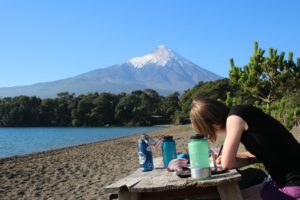Seasonal Change at the Alzar School
Turning leaves and falling temperatures elicit mixed emotions for me. I grew up in New England farm country; crisp hayrides and the crunch of leaves underfoot harken back to a childhood dominated by seasonality. Having spent 13 months of the last three years in the southern hemisphere, I’m craving a full calendar year in one place–preferably one with vibrant foliage, copious mud, and snow measured by the foot. In some ways, though, I’ve adopted a new form of seasonality: one dominated by cultural shifts rather than climatic ones. Three days to go before our semester leaves for southern Chile, I find myself reflecting on how much our lives change in mid-October–and how much stays constant.

Each semester, our school spends three weeks in our adopted homes of Choshuenco and Neltume: small villages in the shadow of an active, snow-capped volcanoes. Students split time between the two towns, taking half of their classes in each town. Teachers get an extended block schedule to delve deeper into their curriculum, and the whole community gets the unique opportunity to live, shop, play and learn in a place quite different than their own. We ask a great deal of our students in Chile. Non-traditional classrooms require driven students, and so much of the learning happens outside of the classroom. Everyday tasks like ordering dinner go from routine interactions to an authentic learning opportunity.
For their part, our students are characteristically eager for a new set of challenges. Shirley, from Westwood, Massachusetts, finds consistency in the community of learners surrounding her: “My whole idea of Alzar was that it didn’t matter where we were, we were going to be learning anyways… I wanted to get as much in as possible it made a lot of sense that I would move around a little bit.” Shirley is worried about the block classes: “I’m not good at staying focused, so 80 minute blocks might be hard, but we’ll see.” If the past two months are any judge, I think Shirley will do just fine.

